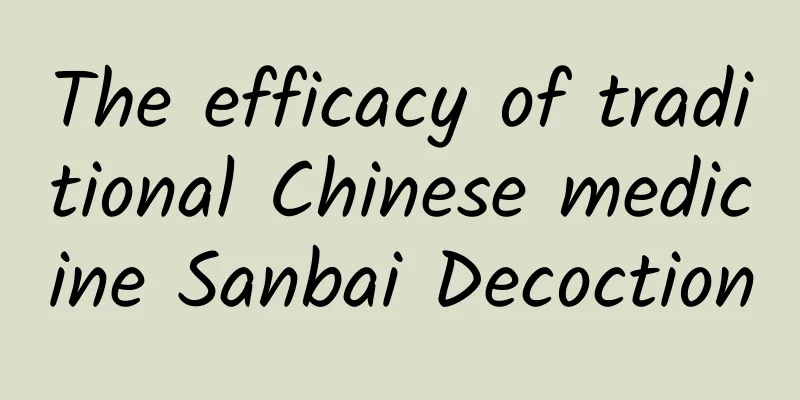The efficacy of traditional Chinese medicine Sanbai Decoction

|
Many people probably don't know what the traditional Chinese medicine Sanbai Tang is. This Sanbai Tang is actually a very common traditional Chinese medicine. Usually, you can choose this Sanbai Tang to treat many diseases, or you can choose Sanbai Tang to improve many adverse phenomena. When choosing Sanbai Tang to treat diseases, we must first know what the effects of this Sanbai Tang are. It is mainly a mixture of several medicines. So what are the effects of the traditional Chinese medicine Sanbai Tang? White peony root, white atractylodes and white poria are traditional medicines for moisturizing the skin and whitening the skin. Together with licorice, they can also delay aging. In traditional Chinese medicine theory, white peony root is sweet and sour, slightly cold in nature, and has the effect of nourishing blood. It can treat sallow complexion, facial pigmentation, and dullness; Atractylodes macrocephala is warm in nature, sweet and bitter in taste, and has the effect of delaying aging; White Poria cocos is sweet and light in taste, neutral in nature, and can remove spots, acne, and whiten the skin; Licorice is neutral in nature, sweet in taste, and has the effect of moisturizing the skin and deodorizing. It is used for bad breath and chapped skin caused by weak spleen and stomach. Modern pharmacological research has also confirmed the cosmetic effects of the above-mentioned medicines: white peony root has the effect of scavenging free radicals and anti-oxidation; Atractylodes macrocephala and white Poria cocos can enhance immune function and dilate blood vessels; licorice has an immunoregulatory effect and can be used externally to protect against the sun, whiten and remove spots, and prevent rough skin, etc. Therefore, many whitening skin care products contain licorice extract. Female friends can go to the pharmacy to buy these four medicines and boil them in water to drink. If you find it troublesome, you can also make your own tea bags. Take 150 grams each of Atractylodes macrocephala, White Peony Root, and White Poria cocos, and 75 grams of licorice. Grind them into coarse powder, mix them evenly, and put them into 30 small bags. Take 1 bag a day, brew it with boiling water, and drink it as tea. Traditional Chinese medicine beauty has a long history. In addition to Sanbai Decoction, there are many prescriptions that have whitening and freckle-removing effects. For example, the Qiongyu Paste (composed of ginseng, raw rehmannia, white poria, and white honey) recorded in "Hong's Collection of Effective Prescriptions" has the effects of invigorating qi and nourishing yin, moisturizing the skin and whitening. This Traditional Chinese Medicine Sanbai Soup is a health-preserving soup that can be used for beauty. When using this Sanbai Soup for beauty, you must pay attention to the dosage and strictly prepare yourself. When choosing Sanbai Soup for beauty, you must also remember not to easily come into contact with ultraviolet rays, otherwise it is easy to have bad skin. This Sanbai Soup can also improve physical weakness. |
<<: Effects of Chinese herbal medicine Polygonum multiflorum
>>: The efficacy of Chinese medicine Qing Banxia
Recommend
The cargo spacecraft does not carry people, is it a manned spacecraft?
Cargo spacecraft are the backbone of manned space...
The risk of death dropped by 12%! Loving to post on WeChat Moments can actually make you live longer?
Recently, we often see heated discussions on the ...
What are the taboos of mistletoe
Mistletoe is a parasitic dried leafy stem and bra...
The efficacy of Lycium bark
I believe that some people are not familiar with ...
Since it was invented, patients with liver disease no longer have to go to the hospital.
When I was in college, I heard a rumor that peopl...
The efficacy and function of mountain sorghum
As people's living standards improve, they pa...
What are the effects and consumption methods of Astragalus?
Wild Astragalus is an extremely precious traditio...
The Devil Boy's Trouble in the Sea, Made It to the Cover of a Top International Academic Journal? Pictures Speak the Truth
The 2025 Spring Festival movie "Nezha: The D...
The efficacy and function of bamboo grass
The medicinal value of bamboo grass is beyond our...
Fist-sized hailstorm hits Guangzhou, smashing through car windows and roofs! How could the hail be so big?
From the afternoon to the evening of April 27, ma...
What is it like to be a bodyguard for a 2-meter-tall Shandong man?
Mixed Knowledge Specially designed to cure confus...
Visualization丨"Tiangong Classroom" will start tomorrow! Review the knowledge points of the first two lessons
END Editor/Gulu...
Student Zhang, you have been called by the fire department!
Recently, on a short video platform Recording the...









